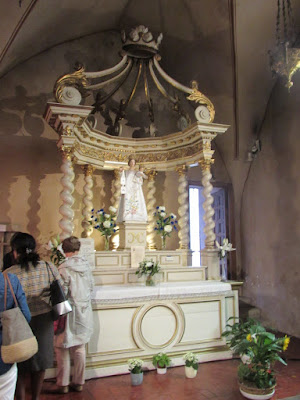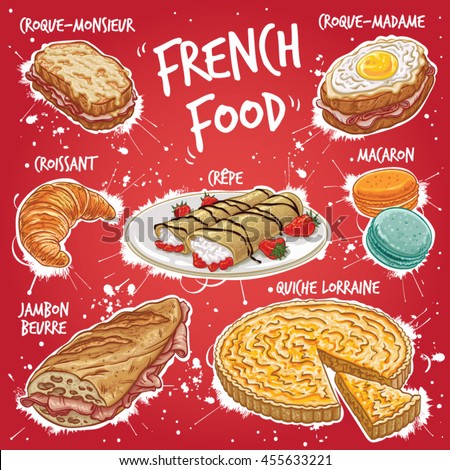I've been on a fast learning curve here at the Centre: French language, French driving, French shopping, layout of the city, routines and duties of the Centre, figuring out where I am and what I'm doing. It's all been good, but every one needs a break sometime--and today was it for me. What I would find out, however, on this brief three-hour journey was that I had touched eternity.
St. Julien Chapteuil
I read (in French) that a blueberry festival was being held in St. Julien Chapteuil (about 30 minutes away), so after a long walk, breakfast, French language studies and a shower, I headed out. It was a gorgeous day on the French countryside in this area called the Haute-Loire (the headwaters of the Loire River). The rolling hills, some of which are extinct volcanoes, made for a beautiful drive.
 |
| St. Julien |
 |
| Front of the 13th century church with a clock tower added in the 19th century |
The church is on the highest point in the city, so the view of the surrounding area was scenic. Like most of the buildings in this area, it was made of basalt, the hardened rock from the many ancient volcanoes of the area.
The sidewalks were paved with panels of small stone, which reminded me of my Uncle Marcel whose company produced these types of panels among other stone products. He was born and bred in Italy so I think I'm beginning to understand him better as I spend time in France amid all the stones. He loved stone and decorated his house with stone.
This love of stone also extended to one of my new French friends. After spending two years in the USA, she was returning to France. What she had missed the most was "the stone."
Stone
Stone is about permanence. It's about cleverly making arches and ceilings that don't collapse on another because they are properly placed and balanced against each other. It's also about a lot of old buildings that are still cared for and respected for what they represent or once housed. Europe is full of stone buildings and it is one of the things that I, too, like about living here. Stone is beautiful and it is of the Earth. It's not fabricated like other building materials, rather, it is cut, polished, and positioned for its greatest effect structurally and aesthetically.


Romanesque cathedrals from the early Middle Ages (1000-1200) are solid, massive, impressive churches that are often still the largest structure in many towns. They feature geometrically-shaped domes with arches and massive columns to support their weighty structures.
The decoration uses geometric shapes rather than floral or curvilinear patterns. The common shapes used were diapers (squares or lozenges), chevrons (zigzag patterns and shapes) and circles, which echoed the half-circle shape of the ubiquitous arches. (from Beginner's Guide to Romanesque Architecture)

Here's the baptismal font in a former chapel space. I liked it for its beautiful arrangement in a designated space. Although many churches today put the font near the entrance of the church, this one was to the right of the altar.
 World War I was something the world had never seen before with 11 million military deaths, 7 million civilian deaths and 23 million wounded. All over Europe there are war memorials. This church had a plaque installed with its war dead, which illustrates the staggering loss of young men from this small town.
World War I was something the world had never seen before with 11 million military deaths, 7 million civilian deaths and 23 million wounded. All over Europe there are war memorials. This church had a plaque installed with its war dead, which illustrates the staggering loss of young men from this small town.Here is an elaborate 19th century wood ambo where the Scripture readings were proclaimed. The bird at the top is a pelican, which is a symbol of Jesus because it feeds its young while it oftentimes goes hungry itself. This ambo is no longer used, but its beauty could not be hidden in a closet, so the parish keeps it in a small side chapel to the left of the altar.
The city's coat of arms is displayed on the balcony railing of the church.
More scenes in the city center of St. Julien Chapteuil that exhibit the use of stone on houses and streets.


This stone pathway dramatically leads up to the church.

This rather plain, garage-like building has become a tourist attraction with a restaurant, café, and souvenir shop for visitors to this quaint village. Of course, it was closed on Sunday.
It's a house now, but this building, which is across from the church, may have housed the monks.
Beautiful stone archways frame the next group of buildings.

Even the trash containers are propped up by stone.
Driving through the French countryside
I love driving. It relaxes me and allows me to be alone with myself, the road and the countryside. I started this habit on the Sunday morning after I bought my first car, a 1972 red Datsun. I drove south from my home in Detroit on the backroads of Telegraph all the way to Sylvania, Ohio. It was a smooth two-lane highway with hardly anyone on it. I would drive many a road like that over the next 45 years....and now I was driving on one in France!!
After I left St. Julien, I headed north of Le Puy to see what was out there. While I drove, I played French rock music on the radio and wove my way along the two-lane highways in the countryside until a sign pointed to the "Valley of the Volcanoes." It's a national park and an irresistible destination, so I pressed on for about an hour before turning back to Le Puy. Here are some of the sights, although my camera does not do justice to the majesty of the landscape.

There were a couple lone crosses like this one on the road. They probably designated early missions of the Church.

























































